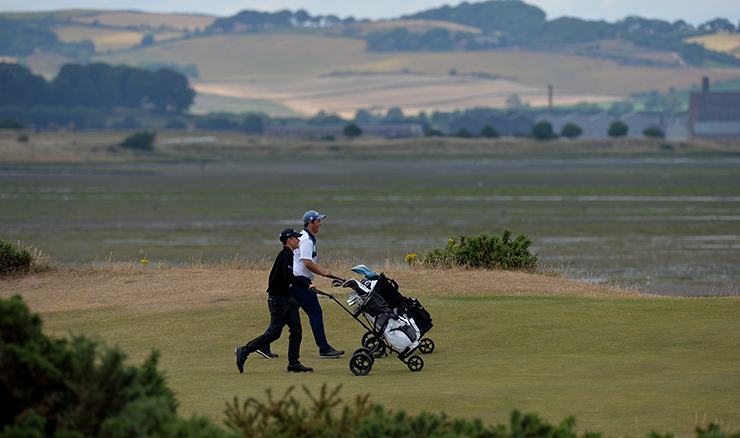01 Nov 2020 | Clubs and Facilities | Feature stories |
A journey to Fife
by Contributor

By Richard Allen Arranging a game at the home of golf, the Old Course at St Andrews, requires more than turning up at the clubhouse and handing over the green fee (£195 in high season, or $350). In peak times you must enter a ballot and hope like hell your name comes up. If it doesn’t, don’t throw your clubs into the Swilcan Burn in a huff, because there are many other wonderful golfing options – both old courses and new – in the Ancient Kingdom of Fife, the outcrop of land in Scotland between the Firth of Forth and the Firth of Tay to the north of St Andrews. For a start, the Old Course has four sister clubs which are well worth a round – the New, the Jubilee, the Eden and the Strathtyrum (www.standrews.org.uk). The New Course is, in reality, not very new at all. Laid out in 1895 by Old Tom Morris, winner of four Open Championships, it is set in the same undulating links land as its more famous sister. Many say it is a more exacting test of golf. It is certainly tighter off the tee and the greens are much smaller. Three holes especially stand out – the par-five eighth, where the third shot must be hit between a narrow gap to a hidden green, the 210-metre par-three ninth hole, which runs parallel to the Eden Estuary, and the par-four tenth hole, where the drive is played from an elevated tee to a blind and sloping fairway. Between the New Course and the sea lies the delightful Jubilee Course, which was opened in 1897 and recently remodelled by Donald Steel. Take note especially of the 15th, a par four of just over 300 metres which requires an exacting tee shot and a precision iron to a small green with a deep swale at the front to catch the weak approach. The Eden is the result of collaboration in 1913 between Harry Colt and Alister Mackenzie. Although not long (less than 6000 metres) it is still a good test of golf. Two classic Colt/Mackenzie short par-four holes remain, where golfers hit to plateau greens next to the Eden Estuary. The Strathtyrum was designed by Donald Steel in 1993 specifically for high-handicap golfers, with wide-fairways and few bunkers. Also in St Andrews is the Dukes course, laid out in 1994 by five-times Open winner, Australian Peter Thomson. It was bought by Herb Kohler (developer of Whistling Straits in Wisconsin) who ordered a major revamp. Seven holes have been changed significantly and a few tees remodelled. (www.thedukescourse.co.uk) Once you have played the St Andrews courses and are keen for a monster-sized challenge, take the 20-minute drive south to Kingsbarns, where a course has been designed and built by Americans Kyle Phillips and Mark Parsinen that will take your breath away (www.kingsbarns.com). Set in rolling dunes with the seas as a backdrop, Kingsbarns provides even the best golfers with a giant test. Its closing holes, especially the twelfth and sixteenth, both of which run along the ocean, are reminiscent of the closing hole at Pebble Beach in California. You would swear that the course was fashioned by nature, but nothing could be further from the truth. The designers are happy to admit that they moved tonnes of earth with bulldozers and excavators. Nearby is St Andrews Bay (www.fairmont.com/st-andrews-scotland/golf/fairmont-standrews-golf/), which looks down upon the dreaming spires of St Andrews from the south. The two courses – The Torrance and The Kittocks – were built after a visit to the area in 1998 by American pharmaceutical magnate Donald Panoz, who decided it was good land for a golf course, or two. The Torrance Course, named after and designed by Sam Torrance, has ocean views from every hole, and opportunities to play links-style running shots on many. Although there are no trees on the course, there are unusual features like stone walls and burns (creeks). The signature hole is the 17th, a 400-metre par four which runs along the top of a cliff, generally into the prevailing wind. The Kittocks Course was designed by Australian Bruce Devlin and American great Gene Sarazen. Eight holes must be negotiated before you reach the sea, and none is more challenging than the sixth, which measures 420 metres from the back tees and requires a long carry for the second shot over a death-or-glory scrubland. The 17th is equally thrilling – a dog-leg par four with the second shot played towards a heavily-bunkered cliff-edge green. Ten minutes beyond Kingsbarns lies the Balcomie Course at Crail (www.crailgolfingsociety.co.uk) which, founded in 1786, is the seventh-oldest golf club in the world. Old Tom Morris laid out the original nine holes in 1895 and added another nine four years later. Golfers from around the world come to witness Crail’s quirky charms, which include two par fours on the front nine measuring 400 metres, and four measuring less than 300. On the back nine are two par fives, three par fours and four par threes. The members don’t seem to mind. A long-past member, Professor Dow, used to say of Crail: “One half hour of the air at Balcomie is worth more than all the medicines in Jimmy Smith’s apothecary shop.” Further round the coast, 25 minutes’ drive from St Andrews, is Elie (www.golfhouseclub.co.uk) which must be the only course in the world with a five-metre submarine periscope on the first tee, to ensure that the fairway is clear before players hit. Once the straightforward opening holes are negotiated the course meanders down the sea, where its true beauty lies. There are no par fives on the course, and only two par threes. The course's signature hole is the 350-metre par-four 13th, which takes players to the far reaches of the course and which legendary course architect James Braid described as "the finest hole in all the country”. You know you are on special golfing turf when you stand on the first tee of the Lundin Course (www.lundingolfclub.co.uk) – half an hour’s drive south of St Andrews on Largo Bay – and look over the wide expanse of the 390-metre first hole, the sea 10 metres below on the left. The course follows the coast for four more holes before turning inland and crossing an abandoned railway line, after which the golfer is faced with several testing par fours. The par-three twelfth, the entire par-five thirteenth and the tee of the fourteenth provide panoramic views of the links below and of the Firth of Forth to East Lothian. This is, simply, golf with great character and charm.
* Richard Allen is a journalist and author and a Golf Australia board member
Join our newsletter
Get weekly updates on news, golf tips and access to partner promotions.
Related News
Watts crowned champion in Canada
Reigning Australian Open champion Michele Watts has won the ISPS HANDA Canadian Open Blind Golf.
Stars gear up for Queensland Strokeplay and Amateur Championships
The 2025 Queensland Amateur Championship begins on August 25.
Aussies on Tour: Duo fighting for FedEx Cup survival
One just survived the initial cut while another will walk the FedEx Cup Playoffs tightrope at this week’s FedEx St Jude Championship in Tennessee.


